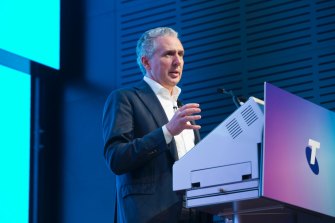Andrew Penn will walk out of the top job at Telstra having overseen more than $20 billion wiped off the telco’s books. Telstra’s shares were trading north of $6.50 when Penn took the reins in May 2015 and are now at $3.90 – down almost 40 per cent over his tenure.
The numbers are terrible, any way you slice it, and Penn has also presided over Telstra cutting its rock-solid dividend payout, not once but twice. First in 2017, when the annual dividend was cut from 31 cents per share to 22 cents per share, and again in 2019, when it was reduced to 16¢.
Along the way, thousands of workers, along with a host of senior executives, have been shown the door as part of Penn’s quest for a leaner, meaner Telstra.
Now that may seem a rather uncharitable report card for Penn, but the value destruction at Telstra is not something he can walk away from. Fortunately for him, this won’t be the legacy he will leave behind when he officially steps down in September.

Telstra chief executive Andrew Penn’s seven-year tenure led to major changes at the telco.Credit:Ryan Stuart
Instead, it will be that of a CEO forced to undertake the sort of fundamental remodelling of a business that can make or break a company. A ‘Kodak moment’, if you will, where a storied behemoth chooses to either face up to the pain or persist into indifference.
Penn’s moment came with the Telstra 22 (T22) strategic restructure, announced in mid-2018, that cut the telco’s workforce of some 30,000 employees by a third, took $2.5 billion of costs out of the business, and a back-end technology simplification that has helped Telstra cut its roster of available mobile plans from 1800 to 20.
But T22 hasn’t been an easy sell to investors, especially retail shareholders that have seen their dividend payments shrink and must reconcile themselves to the reality that Telstra will never deliver the growth it once did.
It’s a reality that Penn has had to contend with since the start of his time as CEO, which began with Telstra scrapping its plans to build a mobile network in the Philippines with local conglomerate San Miguel. That effectively closed the door to meaningful overseas expansion for the business, although it has since been straddled with the Digicel Pacific business, with the federal government doing most of the heavy lifting on that $US1.6 billion ($2.1 billion) deal.
Then came the string of major network outages starting in 2016, which left millions of customers without a service. The disruptions were a serious blow to Telstra’s reputation and prompted it to pour millions of dollars into its 4G networks.








